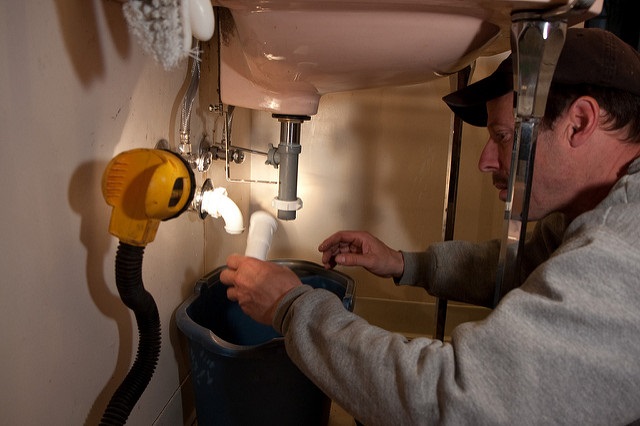A plumber diagnoses the source of a leaky pipe (image courtesy of Ocean Yamaha)
Considering plumber training and wondering what kinds of problems you'll face on a day-to-day basis?
Home and commercial building owners often wait till the last minute to seek professional plumbing help. When you get there, you will often encounter ill-fated attempts at DIY fixes and neglected issues that have multiplied into messy and expensive jobs.
And of course, you will get called in to fix those pesky little plumbing problems we all face from time to time—the routine water and drainage issues that derail our routines and totally disrupt our lives.
This post looks at three such problems and how you can expect to handle them after finishing plumbing training.
Running Toilets: Simple Fixes to Diagnostic Troubleshooting
Many people will tolerate and work around a running toilet for quite a while before calling in a professional plumber. Some will try jiggling the handle just right to make the water stop running, while others will attempt to replace the inner workings of the toilet.
DIY toilet repair kits are inexpensive and fairly straightforward to install. But not all homeowners feel comfortable doing even simple repairs on their own, and will call in a plumber to ensure the installation is done properly and the problem is fully resolved.
In many cases, the source of a running toilet will be easy to spot. You'll look for:
- A rough, eroded, or chipped flush valve
- A damaged flapper or tank ball
- A faulty flush lever assembly
- A dirty, clogged, or damaged fill valve
If none of these components are the culprit, you may have to troubleshoot a bit further. A running toilet may also be caused by sediment that interferes with flushing and filling. Or there may be a silent leak, in which case you would perform a simple leak test by adding a few drops of food colouring to the tank and then watching for any hint of colour in the bowl. If there's colour, you've got a leak.
Blocked Drains: Routine Clogs to Hazardous Consequences
One of the top DIY plumbing mistakes homeowners make is using drain cleaner as a cure-all for clogged sinks, tubs, and toilets. While a good plunging and a bit of drain cleaner can be helpful in some cases, they are not good solutions for chronic clogs caused by substantial blockages.
When the homeowner gets fed up with a blocked drain, the plumber is called in to find and fix the source of the problem. Typical approaches include:
- Using a snake or auger to snag and remove debris from the pipe
- Checking for venting issues (a faulty gulp valve, or blocked vent pipe on the roof of the building)
- Forcing highly pressurized water into the drain
- Verifying the drain line was correctly installed (ensuring the pipe has been set at the proper slope)
Clogged drains are not only annoying, they can also be hazardous. For example, serious venting problems can cause sewage gas to leak into the home, exposing occupants to toxic hydrogen sulfide.
The smell of sewage is considered a plumbing emergency and must be quickly diagnosed and resolved by a trained professional.
Leaky Pipes & Dripping Faucets: Wastage & Damage One Drop At a Time
While the signs of water leakage may seem minimal at first, the consequences can be costly—in terms of both a higher-than-usual water bill and damage behind the walls of a home.
When water runs where it shouldn't, mold growth and structural damage aren't far behind. In many cases, you'll need to open up a wall or ceiling to locate and repair a leaky pipe. Leaks typically happen at the joints, but there are many potential causes and symptoms to consider, such as:
- Old and corroded pipes
- Clogged drains that cause a pipe to leak or burst
- A damaged seal around an appliance water connector
- Temperature changes that have caused a pipe to form crevices through which water leaks
- Unregulated water pressure that causes pipes to burst or crack
- A DIY repair job gone wrong
Meanwhile, a dripping faucet can send gallons of wasted water down the drain. Homeowners often try a few simple fixes on their own before calling in a plumber to sort out the problem. The culprit is usually a damaged or dislodged silicone-based washer that fails to form a watertight seal once a tap is turned off.
However, some faucets use ceramic plates that fit together to form a seal, which involves a more complex repair job.
Quality plumber training prepares students to install, repair, and maintain various kinds of piping, including ABS, PVC, copper, steel, and PEX. Plumber courses also prepare apprentices to evaluate overall piping systems and determine whether a total overhaul is needed to bring old, out-of-date, leaky pipes up to code.
Interested in learning more about becoming a plumber, or choosing a reliable plumber program in the Toronto area?
Your next step is to speak with a Herzing College admissions advisor. They will guide you through the plumber program and explain costs, financial aid, how to apply, and more.
Chat live with an advisor now. Or click below to explore the program in more detail. We're here to help!






